Molluscs
.
Molluscs are easily recognised because their bodies are enclosed, wholly
or in part, by a hard calcareous shell. Two classes of the phylum Mollusca
occur in fresh water: the Gastropoda (snails) and Bivalvia (clams and
mussels).
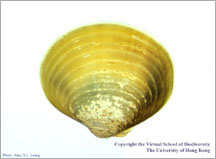 |
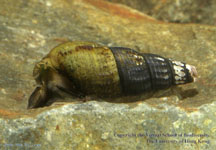 |
Gastropoda
Gastropods live within a single shell that is usually conical, spiraled
or tent shaped. They are divided into the Prosobranchia, which possess
gills for respiration under water and close the mouth of the shell with
a horny operculum, and the Pulmonata that have an air-filled lung and
no operculum. Both forms can live continually submerged unless the water
contains little dissolved oxygen. Prosobranchs generally have thick, hard
shells that are difficult to crack and which may be ornamented with spines
and ridges. Pulmonate shells are usually quite thin and rather smooth.
Snails use a radula (a file-like 'tongue') to scrape up biofilm (especially
algae) on the surface of rocks or macrophytes; detritus, fresh vegetation,
carrion, bacteria and fine organic material are eaten also.
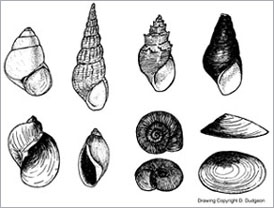 As
a broad generalisation, tropical regions are richer in freshwater prosobranch
snails than in pulmonates, with prosobranchs generally making up over
75% of the species in a given habitat. Some such as the Pilidae or Apple
snails can, as their common name suggests, grow quite large. The Mekong
River has an exceptionally rich prosobranch fauna (See Section 8 on the
'Mekong molluscs'). Running waters tend to be richer in prosobranchs,
while pulmonates are more often found standing waters. However, pulmonates
can become extremely abundant in rivers that are organically polluted
where elevated nutrient levels contribute to dense algal growths and increased
food availability. Prosobranchs in Asia have been the subject of considerable
attention because of the role of some species (e.g., Melanoides, Oncomelania,
Semisulcospira, Neotricula and Tricula) as intermediate hosts
of parasitic flukes that infect birds and mammals (including man) as final
hosts. Schistosoma mekongi is one such blood fluke that has caused
concern in the Mekong basin. Pulmonates of the family Lymnaeidae and Planorbidae
can also serve as intermediate hosts of flukes that infect humans and
domestic animals. One prosobranch, the introduced 'golden snail' (Pomacea
canaliculata: Ampullariidae) from South America, has become widespread
in the Mekong Basin where it is a pest of irrigated crops. Some prosobranchs
can be used as human food, and snails make up an important part of the
diet of some river birds.
As
a broad generalisation, tropical regions are richer in freshwater prosobranch
snails than in pulmonates, with prosobranchs generally making up over
75% of the species in a given habitat. Some such as the Pilidae or Apple
snails can, as their common name suggests, grow quite large. The Mekong
River has an exceptionally rich prosobranch fauna (See Section 8 on the
'Mekong molluscs'). Running waters tend to be richer in prosobranchs,
while pulmonates are more often found standing waters. However, pulmonates
can become extremely abundant in rivers that are organically polluted
where elevated nutrient levels contribute to dense algal growths and increased
food availability. Prosobranchs in Asia have been the subject of considerable
attention because of the role of some species (e.g., Melanoides, Oncomelania,
Semisulcospira, Neotricula and Tricula) as intermediate hosts
of parasitic flukes that infect birds and mammals (including man) as final
hosts. Schistosoma mekongi is one such blood fluke that has caused
concern in the Mekong basin. Pulmonates of the family Lymnaeidae and Planorbidae
can also serve as intermediate hosts of flukes that infect humans and
domestic animals. One prosobranch, the introduced 'golden snail' (Pomacea
canaliculata: Ampullariidae) from South America, has become widespread
in the Mekong Basin where it is a pest of irrigated crops. Some prosobranchs
can be used as human food, and snails make up an important part of the
diet of some river birds.
The shells of freshwater snails can vary greatly in form and shape within
a species, and this is noticeable also in the ornamentation and degree
of elongation of the shells (and especially in the prosobranch family
Thiaridae). However, the opposite applies also; some species differ in
internal structure, while their shells appear very similar. Care is needed
in species identification.
Bivalvia
Bivalves are characterised by possession of a shell that is divided into
two equal halves (or valves) hinged dorsally by an elastic ligament and
closed by powerful muscles. The body is enclosed within the shell, and
has large gills for respiration. The gills also play a vital role in filtering
tiny food particles from water that is pumped in and out of the shell
cavity, entering and leaving via a pair of short siphons. A foot that
can be protruded beyond the shell valves allows the animal to burrow into
riverbeds. In many areas bivalves are a popular human food, and the large
species living in shallow sections of river are often heavily exploited.
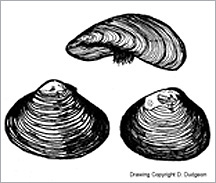 Freshwater
bivalves are most diverse in large rivers and floodplain lakes, but some
taxa (Corbiculidae and Sphaeriidae) occur in small streams also. They
vary considerably in size: the Fingernail clams (Sphaeriidae) are mature
at less than 10 mm long, while some Unionidae reach lengths of 25 cm.
A few specialised forms, such as the mussel genus Limnoperna (Mytilidae),
attach to hard surfaces
Freshwater
bivalves are most diverse in large rivers and floodplain lakes, but some
taxa (Corbiculidae and Sphaeriidae) occur in small streams also. They
vary considerably in size: the Fingernail clams (Sphaeriidae) are mature
at less than 10 mm long, while some Unionidae reach lengths of 25 cm.
A few specialised forms, such as the mussel genus Limnoperna (Mytilidae),
attach to hard surfaces 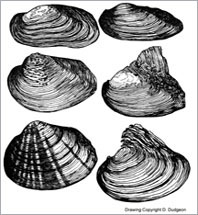 (using
thread-like secretions called byssus), but most bivalves burrow in stable
gravel, sand or mud substrates. The largest of these families (made up
of several hundred species worldwide and including the vast majority of
freshwater bivalves) is the Unionidae. Certain Unionidae require a particular
type of fish host for development as their larvae, called glochidia, must
go through an ectoparasitic developmental stage on fish gills or fins
before settling in the riverbed as a juvenile. Such most-specific unionids
may be limited in their distribution by the availability of suitable fish
host species. Other unionids have less particular host requirements (although
all unionids require fish hosts of some type) but are highly are habitat
specific, and will only thrive under certain combinations of current,
water chemistry and substratum. These specialised characteristics can
make unionids especially vulnerable to human modification of the environment.
(using
thread-like secretions called byssus), but most bivalves burrow in stable
gravel, sand or mud substrates. The largest of these families (made up
of several hundred species worldwide and including the vast majority of
freshwater bivalves) is the Unionidae. Certain Unionidae require a particular
type of fish host for development as their larvae, called glochidia, must
go through an ectoparasitic developmental stage on fish gills or fins
before settling in the riverbed as a juvenile. Such most-specific unionids
may be limited in their distribution by the availability of suitable fish
host species. Other unionids have less particular host requirements (although
all unionids require fish hosts of some type) but are highly are habitat
specific, and will only thrive under certain combinations of current,
water chemistry and substratum. These specialised characteristics can
make unionids especially vulnerable to human modification of the environment.